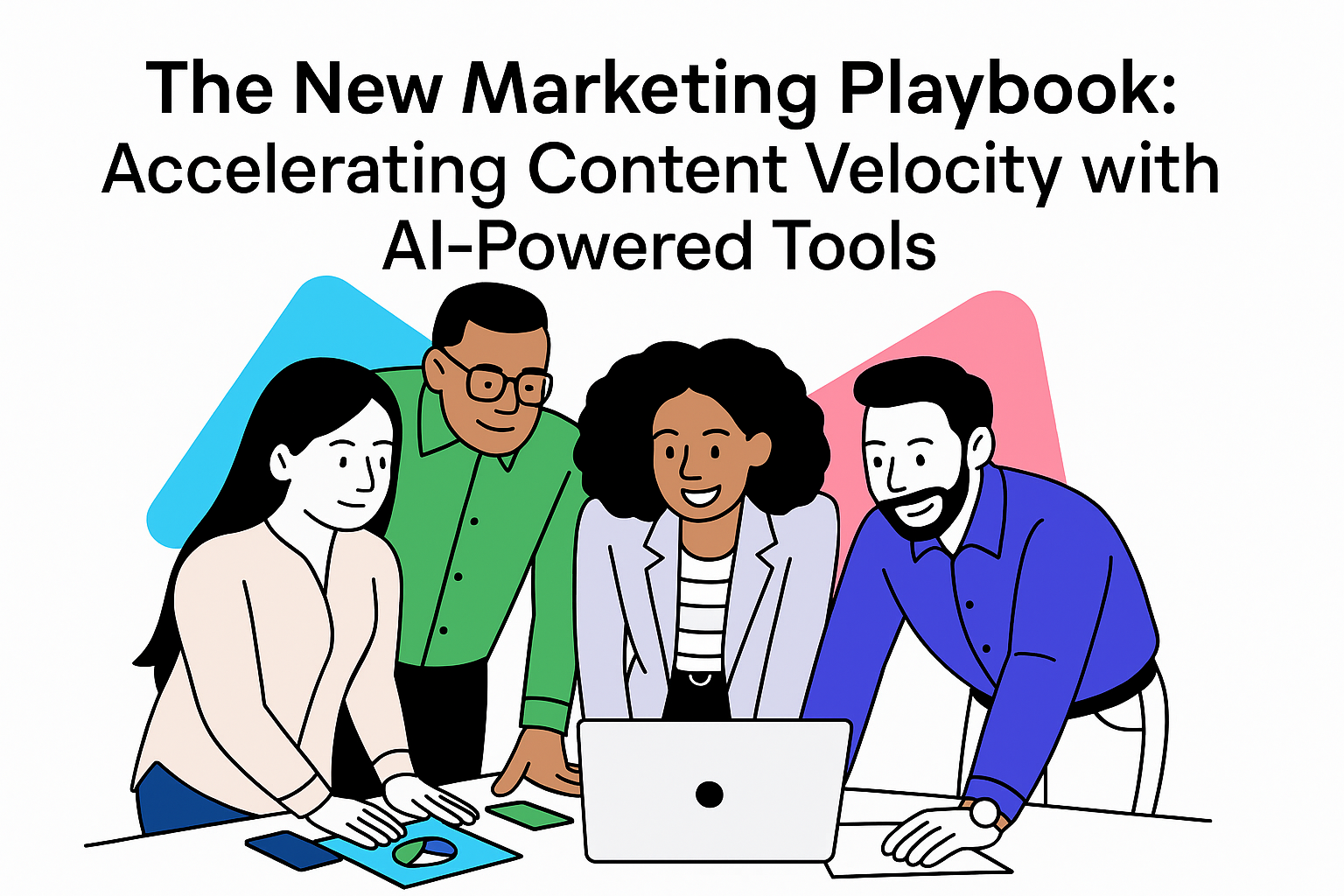
Marketing has always been about relevance, but in 2025, relevance has a speed requirement. Today’s most successful brands aren’t just producing great content, they’re producing it fast and at scale. Content velocity, the ability to consistently generate and distribute high-impact content across multiple channels, has become a defining metric for marketing performance.
The shift is being driven by three converging pressures. First, content consumption is at an all-time high. Buyers expect brands to show up everywhere, LinkedIn, YouTube, email, and industry blogs, and they expect it often. Second, attention spans are shorter, and competition is fiercer. If your brand isn’t first to weigh in on a trend or deliver timely insights, someone else will. Third, traditional marketing workflows can’t keep up. Agencies are expensive and slow. Internal teams are stretched thin.
What’s changed is that AI has made scale possible without more headcount. Tools like Lumen5, Jasper, and Canva have allowed lean teams to produce more content in less time, and bring previously outsourced work back in-house. According to HubSpot’s 2025 State of Marketing Report, 64% of marketers say AI tools have helped them increase content production without increasing costs.
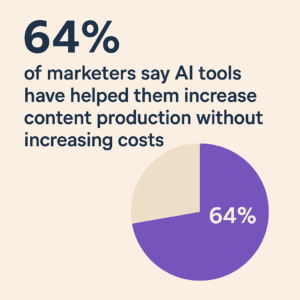
This isn’t about replacing creativity with automation. It’s about removing bottlenecks, accelerating workflows, and giving your team the tools to compete at the pace the market demands. In this playbook, we’ll break down how AI is reshaping content operations, how you can scale your brand without scaling your team, and what it takes to build a high-velocity content engine inside your organization.
The Velocity Imperative: Why Fast, Consistent Content Wins
Speed is no longer a competitive advantage, it’s a baseline requirement. In 2025, marketing teams that consistently produce and publish content at a high frequency are outperforming those that don’t. Content velocity, once a nice-to-have, has become a key differentiator in how brands capture market attention, drive pipeline, and stay relevant.
High content velocity drives clear business outcomes. According to Semrush’s 2025 Content Marketing Report, companies that publish content multiple times per week generate 3.5 times more organic traffic than those that publish less frequently. More visibility leads to more engagement, which translates into more conversions. It’s a volume game, but one that requires precision, not noise.
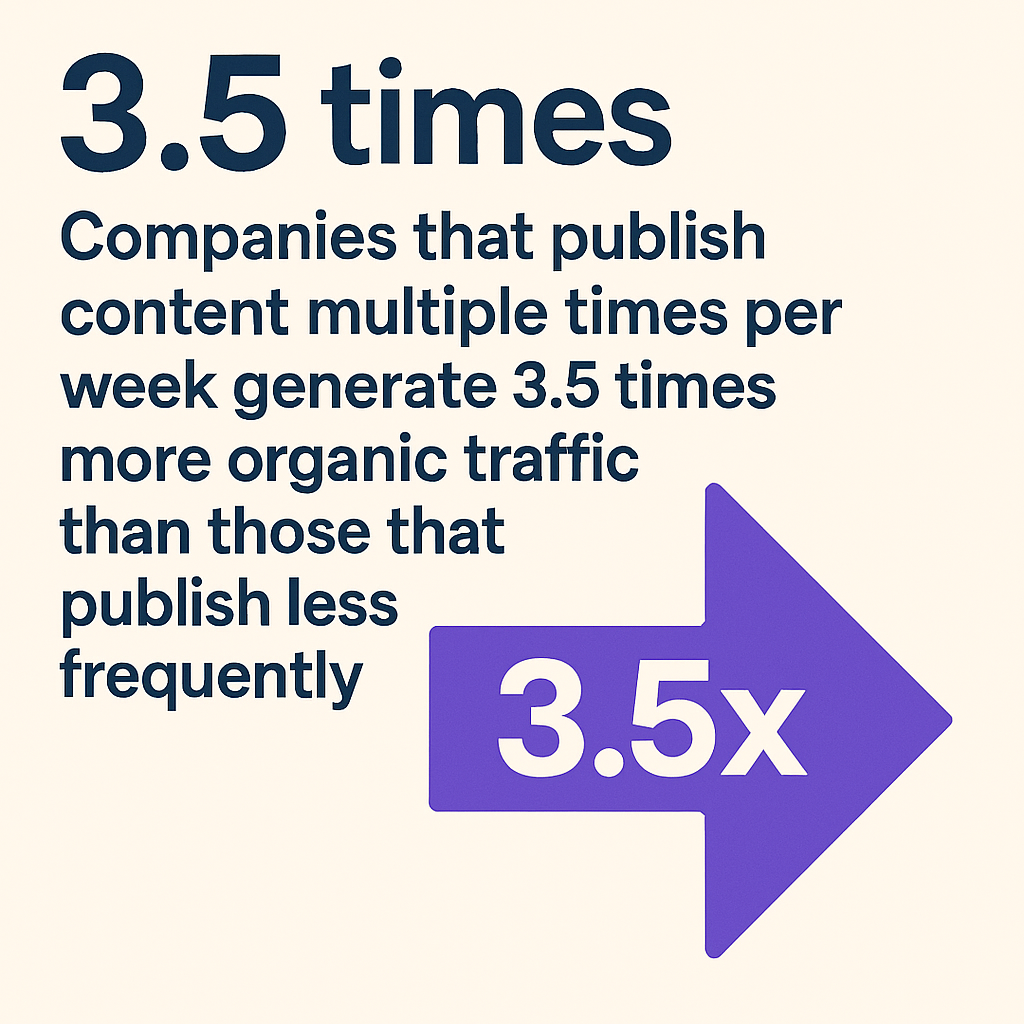
Velocity also plays a critical role in brand perception. Fast-moving teams are seen as more innovative, more plugged-in, and more in tune with current conversations. This is especially important for B2B brands competing in saturated markets. As trends and customer needs shift quickly, lagging behind, even by a few days, can mean missing the moment.
But velocity isn’t just about publishing more. It’s about removing friction from the content lifecycle. Too many enterprise marketing teams still operate on outdated cadences, monthly editorial calendars, multi-week production timelines, and multi-layered approval processes. These systems were built for a different era.
The new standard is fast, flexible, and iterative. It means empowering marketers to create, test, and optimize content in real time. It means turning around video assets in hours, not weeks. And it means developing systems that allow for scale without sacrificing quality or brand alignment.
As we’ll explore in the next section, the biggest barrier to achieving this level of velocity isn’t talent or creativity, it’s process. And that’s where traditional content operations start to fall apart.
Traditional Content Creation Can’t Keep Up
The biggest friction point in modern marketing isn’t creativity, it’s execution. Traditional content creation models, especially those built around agency dependencies and slow internal processes, are fundamentally mismatched with the speed of today’s market.
Start with the agency model. While agencies bring creative firepower, they’re inherently slow and expensive. Briefs, scopes, production cycles, revisions, feedback loops, all of it adds weeks to a timeline. By the time the final asset is delivered, the market conversation may have already moved on. According to a 2023 study by the ANA, 82% of large brands have brought at least part of their creative work in-house over the past two years, primarily to move faster and reduce costs.
Internal processes aren’t much better. Enterprise teams often face layer upon layer of approvals, compliance reviews, and stakeholder sign-offs. A single blog post or product video can sit in limbo for weeks. The Content Marketing Institute reports that 72% of marketers cite slow internal workflows as the top barrier to producing content at scale.

This gap between strategy and execution is growing wider. Marketing leaders are under pressure to do more, more channels, more formats, more campaigns, but legacy workflows weren’t designed for this level of complexity or speed.
The result? Bottlenecks. Missed opportunities. Stale content. And over-reliance on outsourced partners who can’t move at the pace your business requires.
The good news is that this model is no longer necessary. With the right AI-powered tools, lean internal teams can execute at the speed of market, creating everything from video to social to sales collateral in a fraction of the time. In the next section, we’ll look at how those tools are changing the way content is built, published, and scaled.
AI-Powered Tools: The Game Changer for Content Creation
AI isn’t just a buzzword in marketing anymore. It’s infrastructure. Today’s most agile marketing teams are using AI-powered tools to eliminate production bottlenecks, reduce costs, and scale content creation with a level of efficiency that would’ve been unthinkable just a few years ago.
The evolution started with copywriting assistants like Jasper and Writer, which help generate blog posts, email copy, and ad creatives using prompts and brand voice guidelines. Now, it’s expanded into video, design, and even full campaign workflows. Tools like Lumen5 can turn a blog post into a branded video in minutes, complete with dynamic visuals, captions, and voiceover, all without a video editor. Platforms like Canva’s AI suite allow marketers to generate visual assets at scale with brand templates built in.
This shift is measurable. According to McKinsey, marketing teams using generative AI tools have reduced content production timelines by up to 70%, while increasing output volume by two to three times. That means more videos, more social content, more experiments, and faster feedback loops to optimize what works.

It’s not just about speed. AI tools are helping enforce brand consistency across distributed teams. For example, Jasper allows organizations to lock in brand tone and voice across all outputs. Lumen5 lets marketers create on-brand video templates that any team member can reuse. This removes reliance on senior creatives for every asset and ensures alignment at scale.
Perhaps most importantly, these tools democratize creation. You no longer need a dedicated designer to create high-quality visuals. You don’t need a videographer to publish polished videos. And you don’t need a team of writers to keep your content pipeline full.
The outcome is a marketing organization that can move quickly, test constantly, and scale consistently, without burning out your team or blowing up your budget.
In the next section, we’ll explore how this transformation enables enterprise teams to shift content production in-house and scale brand presence without scaling headcount.
In-House Is the New Agency: Scaling Without Headcount
For decades, agencies were the only way to scale content production. They had the tools, the talent, and the infrastructure that internal teams lacked. But in 2025, that equation has flipped. AI has leveled the playing field, enabling in-house marketing teams to operate like creative studios, without the overhead.
This shift is accelerating. According to a 2023 ANA report, 82% of major brands have moved some or all of their content creation in-house, with speed, cost savings, and control cited as the top drivers. It’s not just creative control. It’s operational flexibility. When teams aren’t reliant on third parties, they can turn around assets in hours, not weeks.
Tools like Lumen5, Jasper, and Canva are giving marketing teams the power to execute full campaigns internally, from copy to video to design. Instead of briefing an agency and waiting on timelines, marketers can produce assets in real time, test across channels, and iterate based on performance. The result is a faster go-to-market cycle and tighter feedback loops.
This is especially valuable for lean teams under budget pressure. A Gartner survey found that 71% of CMOs faced budget constraints in 2024, even as content demands increased. Scaling brand presence without adding headcount or agency spend is no longer optional, it’s the only viable path.

And the impact goes beyond cost savings. In-house teams often produce stronger work because they understand the brand more deeply. They have direct access to subject matter experts. They sit in on strategy meetings. They’re closer to the customer. When equipped with the right tools, this proximity translates into content that is faster, smarter, and more aligned with business goals.
In the next section, we’ll break down the practical steps marketing leaders can take to operationalize this shift, from process design to team enablement.
Practical Steps to Implement AI-Driven Content Velocity
Making the leap to AI-powered content operations requires more than just adopting new tools. It’s a shift in process, structure, and culture. For marketing leaders, the challenge is to implement systems that accelerate output while maintaining strategic alignment and creative quality. Here’s a practical roadmap to make that transition:
1. Audit Your Current Content Workflow
Start by identifying friction points in your existing content lifecycle. Where do delays happen? Is it creative development, reviews, or cross-functional approvals? Map the end-to-end process and measure your current velocity, how long does it take to go from idea to publish across formats?
2. Define Clear Velocity Metrics
Set benchmarks that reflect the pace you want to achieve. These might include:
- Average time to publish per content type
- Weekly content volume by channel
- Production cost per asset
Use these KPIs to track progress as you introduce AI tools and process changes.
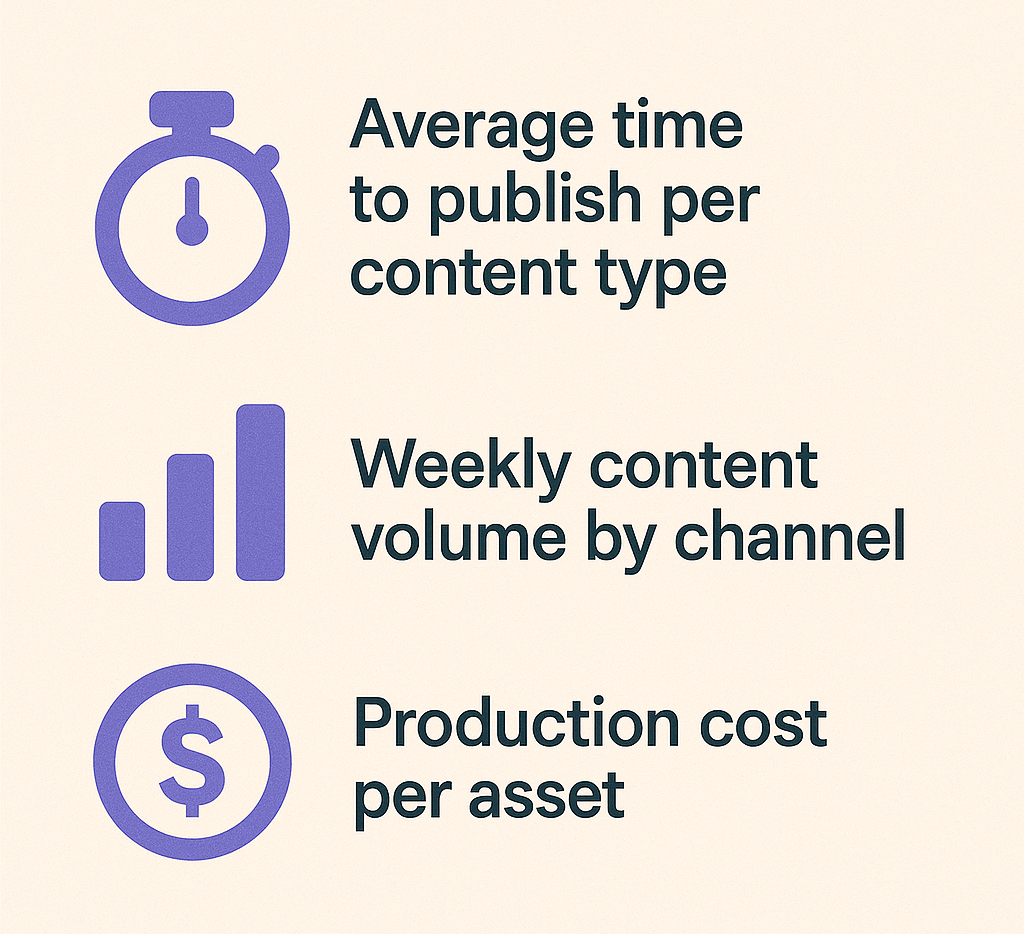
3. Select Tools That Fit Your Needs
Not every AI tool is built for every team. Choose based on your most time-consuming formats:
- Video: Use Lumen5 to convert blogs, webinars, and scripts into branded videos quickly.
- Copywriting: Use Jasper or Writer for blogs, emails, and ads.
- Design: Use Canva AI to generate and scale branded visual content.
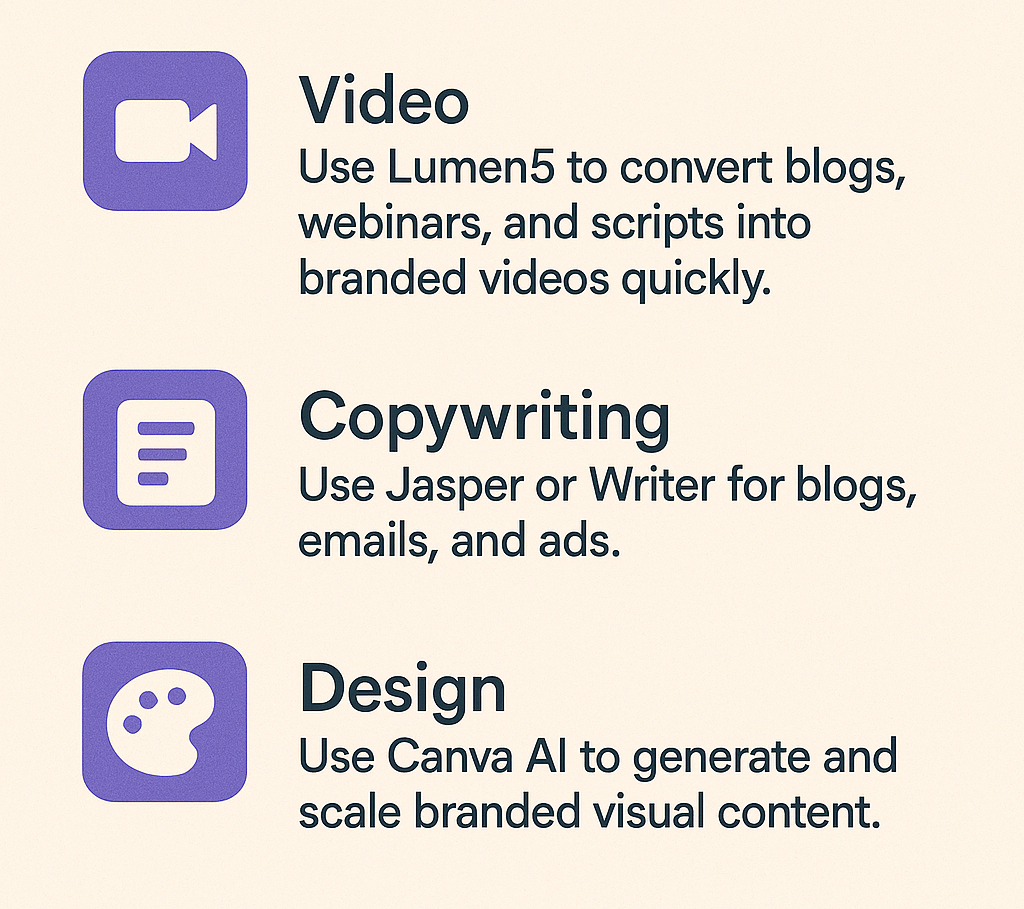
4. Train Your Team and Establish AI Guidelines
Roll out training sessions and create internal best practices for using AI responsibly and effectively. Teach your team how to edit, review, and iterate on AI-generated content to maintain quality and voice.
5. Build Reusable Templates and Frameworks
Create pre-approved templates for blogs, videos, and social posts. These reduce review cycles and ensure brand consistency. Platforms like Lumen5 and Canva allow teams to lock in templates for easy reuse.
6. Implement a Feedback and Optimization Loop
Use analytics to measure what’s working and refine accordingly. Many AI tools include built-in performance insights. Incorporate that data into your weekly or monthly content planning.
Done right, this system becomes a repeatable engine. One that scales content velocity, preserves quality, and aligns with business goals, without burning out your team.
How to Maintain Content Quality and Brand Governance at Scale
Speed is powerful, but without structure, it can lead to chaos. As marketing teams adopt AI to increase content velocity, they must also build guardrails to maintain quality, consistency, and control. These are the three most common risks leaders need to navigate.
1. Content Quality
AI tools accelerate creation, but they don’t guarantee excellence. Outputs can be generic, off-brand, or factually incorrect if used without oversight. The solution is human-in-the-loop editing. Assign reviewers or editors to refine AI-generated content and ensure it meets your creative and strategic standards. As McKinsey notes, companies combining AI with human review see significantly better performance and fewer reputational risks.
2. Brand Consistency
As more team members create content faster, the risk of brand voice fragmentation grows. Tools like Jasper and Writer help mitigate this by allowing you to define brand voice guidelines and enforce them across content types. Standardizing templates across video (Lumen5), design (Canva), and copy can also help maintain a unified brand experience at scale.
3. Brand Governance and Creative Oversight
Velocity without strategy leads to noise. Teams need editorial frameworks, content calendars, and clear messaging priorities, even when using AI. Establish review checkpoints for campaign-level assets and use AI for tactical, repeatable content. This ensures alignment without slowing down.
Leading organizations don’t treat AI as a free-for-all. They build disciplined systems that harness automation while preserving what makes their content distinctive: insight, creativity, and consistency. The key is using AI not as a shortcut, but as a structured force multiplier.
The Future Belongs to Agile, AI-Driven Marketing Teams
Marketing has entered a new era, one where speed, scale, and strategic clarity define success. The old model of long lead times, siloed teams, and agency-heavy workflows no longer fits the demands of modern content consumption. Today, the most effective marketing organizations are fast, flexible, and fully equipped to produce content in-house with AI at the core.
This is not a race to automate creativity. It’s a race to remove bottlenecks and unlock your team’s full potential. AI tools like Lumen5, Jasper, and Canva are giving lean teams the power to scale without sacrificing quality or voice. The brands that win in 2025 will be those that build operational systems around velocity, not just volume.
The playbook is changing, and the time to act is now. Marketing leaders must rethink their workflows, retool their teams, and embrace a new era of content creation that favors agility, experimentation, and intelligent automation.
If you’re ready to move faster, produce smarter, and scale with precision, explore how Lumen5 can help you build a high-velocity content engine that drives real business growth.





